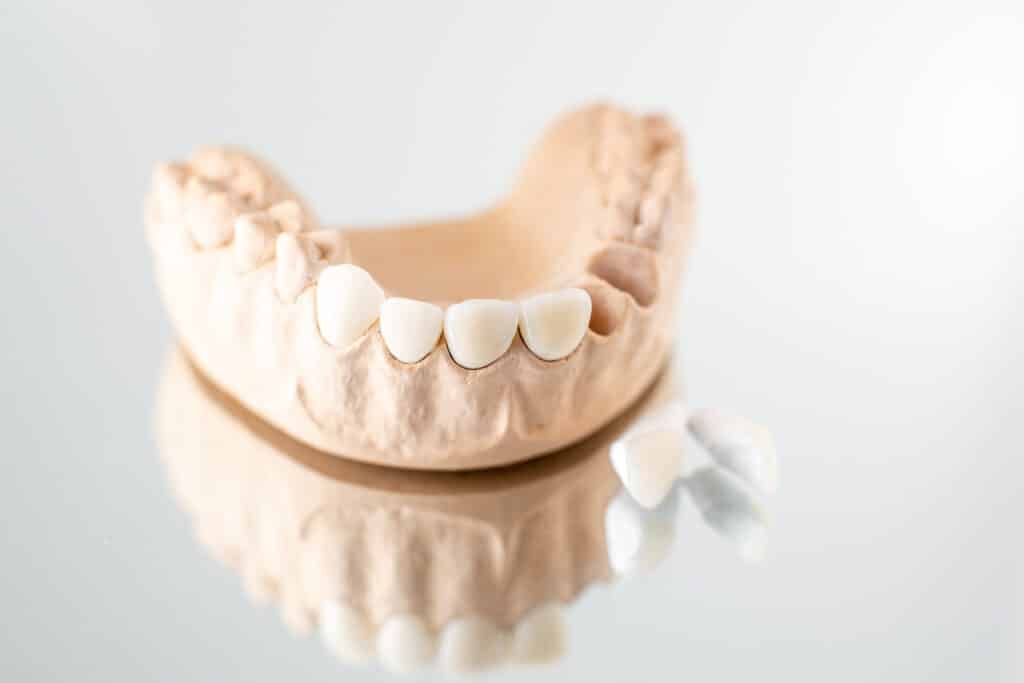Having a healthy and beautiful smile is important for everyone. Dental crowns and bridges are common solutions for restoring damaged or missing teeth. They help improve both the function and appearance of your teeth. Understanding what these dental treatments are, the materials used, and how the procedures work can help you make informed decisions about your oral health.
Dental crowns are caps that cover a damaged tooth, making it stronger and improving its shape and appearance. They are often used when a tooth has a large filling and not much natural tooth left, or after a root canal. Bridges, on the other hand, are used to replace one or more missing teeth. They are anchored to the surrounding teeth or implants, filling in the gap and restoring your smile.
At Pickering Dental Services, we believe that knowing more about your treatment options can help ease any worries you might have. With that in mind, let’s explore what dental crowns and bridges are, the different materials they can be made from, the steps involved in getting them, and how to care for them to ensure they last a long time.
What Are Dental Crowns and Bridges?
Dental crowns and bridges are two types of dental restorations that help repair damaged or missing teeth. A dental crown, also known as a cap, is placed over a damaged tooth to restore its shape, size, strength, and appearance.
Crowns are typically used for teeth that are cracked, worn down, or have large fillings. By covering the tooth, they provide protection and support, helping the tooth function like a normal, healthy tooth.
A dental bridge, on the other hand, is used to replace missing teeth. It consists of two or more crowns for the teeth on either side of the gap, known as abutment teeth, and a false tooth (or teeth) in between.
The false tooth, called a pontic, can be made from various materials such as gold, alloys, porcelain, or a combination of these materials. Bridges are anchored to the surrounding teeth or dental implants to ensure they stay in place, providing both functional and aesthetic benefits.
Materials Used for Dental Crowns and Bridges
Dental crowns and bridges can be made from several different materials, each offering its unique advantages. Here are some of the most common materials used:
1. Porcelain:
Porcelain crowns and bridges are popular because they closely mimic the natural look and feel of teeth. They can be colour-matched to the surrounding teeth, making them an ideal choice for front teeth. However, while they are aesthetically pleasing, they may not be as strong as other materials.
2. Metal:
Metal crowns and bridges, made from gold or alloys, are known for their durability and strength. They are less likely to chip or break, making them a good choice for molars where the chewing force is higher. However, their metallic colour makes them less suitable for visible front teeth.
3. Porcelain-Fused-to-Metal (PFM):
PFM crowns and bridges combine the strength of metal with the natural appearance of porcelain. The metal structure provides excellent support, while the porcelain overlay gives a tooth-like appearance. This makes PFM a versatile and commonly used material in many dental restorations.
4. Zirconia:
Zirconia crowns and bridges are known for their strength, durability, and natural look. Zirconia is a high-quality ceramic material that can withstand substantial wear and tear while maintaining a pleasing appearance. It is a popular choice for both front and back teeth due to its combination of aesthetics and functionality.
Choosing the right material for your dental crowns and bridges depends on your individual needs, including the location of the tooth, aesthetic preferences, and budget. Discussing these options with your dentist will help you make the best decision for your oral health.
The Procedure for Getting Crowns and Bridges
The process of getting dental crowns and bridges usually involves two visits to the dentist. The first visit includes preparation and taking impressions, while the second visit focuses on fitting and placing the crowns or bridges.
First Visit: Preparation and Impressions
During your first visit, we will examine your teeth to ensure that a crown or bridge is the right solution for your dental issue. For a crown, the dentist will shape your tooth by removing a small amount of the surface to make room for the crown. If you’re getting a bridge, the dentist will prepare the abutment teeth by removing a portion of them to fit the crowns that will support the bridge.
After shaping your teeth, we will take impressions using a mould or digital scanner to create a precise model of your mouth. This model helps in crafting custom crowns or bridges that fit perfectly. A temporary crown or bridge will be placed to protect your teeth until the permanent one is ready.
Second Visit: Fitting and Placement
On your second visit, the dentist will remove the temporary crown or bridge and check the fit and colour of the permanent one. Adjustments may be made to ensure it fits comfortably and looks natural. Once everything is perfect, the permanent crown or bridge is cemented into place. We will check your bite to make sure it is aligned properly.
Caring for Your Dental Crowns and Bridges
Taking care of your dental crowns and bridges is essential for ensuring they last a long time. With proper maintenance, they can stay in good condition and function well for many years. Here are some tips to help you care for your crowns and bridges:
1. Good Oral Hygiene
Brush your teeth at least twice a day using a fluoride toothpaste. Make sure to clean all surfaces of your teeth and focus on the area where the crown or bridge meets your gums. Floss daily to remove food particles and plaque between your teeth and around the crown or bridge.
2. Regular Dental Check-ups
Visit us regularly for check-ups and cleanings. During these visits, we will check the condition of your crowns and bridges to ensure they are still in good shape. Professional cleanings can remove any built-up plaque or tartar that regular brushing and flossing might miss.
3. Avoid Hard Foods
While crowns and bridges are durable, they can still be damaged by hard or sticky foods. Avoid chewing on ice, hard candies, or other hard objects that can crack or loosen your dental work. Also, be cautious with sticky foods that can pull at the crown or bridge.
4. Protect Against Teeth Grinding
If you grind your teeth at night, consider wearing a mouthguard to protect your crowns and bridges. Grinding can cause significant wear and tear on your dental restorations, and a mouthguard provides an extra layer of protection.
Enhance Your Oral Health: Understanding Dental Restorations
Dental crowns and bridges are effective solutions for restoring damaged or missing teeth. By understanding the procedures involved and the materials used, you can make informed decisions about your dental care. Proper maintenance and regular check-ups are essential for ensuring that your crowns and bridges last a long time and continue to function well.
At Pickering Dental Services, we are dedicated to providing top-quality dental care to help you maintain a healthy, beautiful smile. Whether you need a dental crown, bridge, or other dental services, we are here to assist you. If you have any questions or would like to schedule an appointment, contact our team of the best dentists in Pickering today. Let us help you achieve the best possible oral health and a confident smile!



